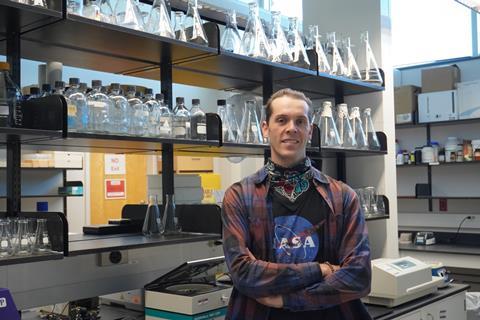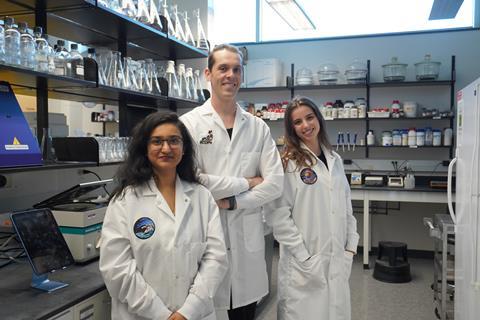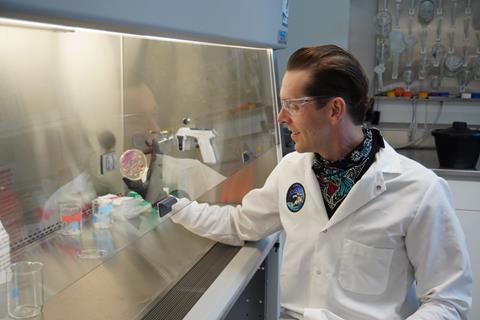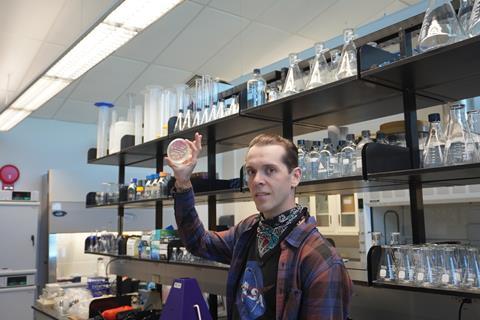Dr Nils Averesch, Assistant Professor of Space Biology at the Space Life Science Laboratory, Cape Canaveral, reveals how his research on microbial plastic production could pave the way for thriving human settlements in space.

Dr Nils Averesch has his gaze fixed on two distant goals. One is to address the very present adnd visible plastic waste crisis on Earth - and the other would pave the way for thriving human settlements in the Earth’s orbit and beyond.
Plastics dominate modern life, yet their production is heavily reliant on fossil fuels and contributes significantly to environmental degradation, he says.
“Most conventional synthetic plastics are hard to recycle, non-biodegradable and energy-intensive to produce. In Space, where resources are severely limited and re-supply costly, the problem of waste management and material production becomes even more acute,” he says.
“My work addresses these dual challenges—earthbound and extraterrestrial—by exploring microbial solutions to create sustainable, high-performance polymers from waste-streams such as carbon dioxide.”
Lego with genes
Dr Averesch was first drawn to microbiology because of the metabolic diversity of microbes and their potential for biochemical engineering and industrial biotechnology: “It’s like Lego with genes,” he says.
As Assistant Professor of Space Biology at the Space Life Science Laboratory in Cape Canaveral, his research focuses on the rational engineering of microbial metabolism to increase the carbon efficiency of biochemical pathways for assimilation of single-carbon compounds and their conversion into advanced biomaterials.
This serves the overarching goal of creating a sustainable chemical industry on Earth “on the way to new frontiers”. By developing circular production platforms based on microbial biotechnology, his work could one day support crewed long-duration space-exploration missions and settlement.
Closed-loop systems
“I envision using microbiology to establish fully sustainable, closed-loop production systems where microbes convert waste—whether carbon dioxide, organic refuse, or industrial by-products—into chemicals for production of essential commodities such as plastics,” he explains.
“Being biogenic, the hypothesis is that these materials should also be readily deconstructable for either recovery of the polymer building blocks - the best case - and upcycling or composting - the last resort. Blending advanced metabolic engineering with environmental sustainability and space applications, this would not only address the global plastic-waste crisis but also provide a foundation for thriving, self-sufficient human settlements off-Earth.”

The respective study that most of his research program is founded on was led by Dr Averesch during his time at Stanford University and was supported by the Stanford Natural Gas Initiative (NGI).
Advanced bioplastics
“More recently, I have received funding from NASA to expand research and development for the conversion of organic and inorganic waste-carbon into advanced bioplastics for manufacturing,” he says.
“Leveraging synthetic biology, I co-opted microbial metabolism to incorporate aromatics in the backbone of biological polyesters. This could pave the way towards the biosynthesis of plastics that are functionally analogous to industrial-grade synthetic polyesters such as PET (Dacron™ / Mylar™) or even polyarylates like the liquid-crystal polymer fiber Vectran™. Enabling the bioproducibility of such materials would redefine the possibilities for sustainable materials production.”
He describes how he introduced a synthetic metabolic pathway into the “knallgas” bacterium Cupriavidus necator, which naturally converts carbon dioxide into biomass under autotrophic conditions, to co-opt its natural ability to form biological polyesters.
Novel class of polymers
“By incorporating a heterologous hydroxyacyl-CoA transferase and a mutant PHA synthase, I enabled the bacterium to biosynthesize bio-polyesters with aromatic rings embedded directly in the backbone. This represents a novel class of polymers previously only accessible through synthetic chemistry.

“The resulting polymers are designed to mimic the structural and functional properties of synthetic materials such as PET and PEF. This could enable the biosynthesis of bioplastic with physicochemical properties (thermal stability, toughness, strength, rigidity) required for manufacturing of durable goods.
“Deconstructable by design, such polyesters would also open the door to producing bioplastics in closed-loop systems, potentially integrating waste recycling and in situ material generation for space missions.”
Surprising outcome
While the fraction of aromatic repeat-units in the obtained polymers was low, it did come as a surprise that the process worked at all, and Dr Averesch was able to co-opt the biochemical mechanism of poly(hydroxybutyrate) formation for the polymerization of aromatic hydroxy acids.
“This was unexpected since the reaction chemistry (think pKa of reactive groups -OH and -COOH, respectively) is much different if an aromatic ring, which draws electrons, is at the center of the polymer building block,” he says.
“Much work is still needed though to reach significant aromatics content to actually modulate the properties of the polymers. This likely hinges on the successful redesign of the enzyme that catalyzes the polymerization reaction: polyhydroxyalkanoate (PHA) synthase.”
Manufacturing in space
However, the discovery could enable two critical challenges to be addressed: reducing the dependence on fossil fuels for polymer production and enabling sustainable manufacturing in space.
“By transforming carbon dioxide—a greenhouse gas—into valuable, durable materials, this research contributes to climate change mitigation and advances the feasibility of long-term space exploration at the same time. Sustainable, on-demand production of high-performance materials could revolutionize industries ranging from packaging to aerospace, enabling circular economies on Earth and resource independence in extraterrestrial habitats on the Moon and beyond,” he says.
The immediate next step would be to refine polymer composition to tune material properties and tailor the polymers for specific applications. This includes increasing the aromatics-content in the bio-polyesters while also optimizing their molecular weight.
Future steps
“Future work will also focus on enhancing polymer yield and process scalability,” he says.
“Tuning thermal stability, flexibility, and durability will be key to unlocking new applications and ensuring bioplastics are competitive. Additionally, testing production and processing of these materials in space-like conditions could validate their potential for extraterrestrial use, advancing sustainable production systems for Earth and beyond.”

Most of his current work is with Cupriavidus necator, since its metabolism offers a roster of useful characteristics ‘out of the box’, including mixotrophy and the ability to utilize diverse feedstocks, such as carbon dioxide, formate and acetate, as well as glycerol and sugars. The microbe is also already able to form bio-polyesters and is relatively receptive to genetic modifications, therefore relatively straightforward to engineer.
“I am also intrigued by methanotrophs (e.g. Methylococcus capsulatus, Methylomicrobium buryatense and M. alcaliphilum, Methylomonas methanica, Methylocystis parvus, Methylosinus trichosporium), some of which can use the two greenhouse gases, methane and carbon dioxide, at the same time. However, these microbes are relatively genetically recalcitrant, so better genetic tools are needed,” he admits.
“There are also other really interesting microbes that can assimilate a variety of single-carbon compounds through unique biochemical pathways, such as Xanthobacter autotrophicus, Hydrogenophaga pseudoflava, Rhodospirillum rubrum, Rhodopseudomonas palustris, Kyrpidia spormannii, most of which are not very well studied, so initially hard to work with.”
Asked what keeps him awake at night, he says: “Sometimes the aircon, sometimes rocket launches, sometimes a new (yet unknown) biochemical mechanism or genetic circuit.”
And the best careers advice he’s ever received? “If doing research, learn to handle frustration. I found it especially fitting with respect to molecular biology,” he admits, half jokingly. ”Second best advice was to be persistent, which is often hard in the face of frustration but does ultimately lead to success!”
Dr Nils Averesch is Assistant Professor of Space Biology at the Space Life Science Laboratory, Cape Canaveral. Find out more about the Averesch Lab HERE.







No comments yet